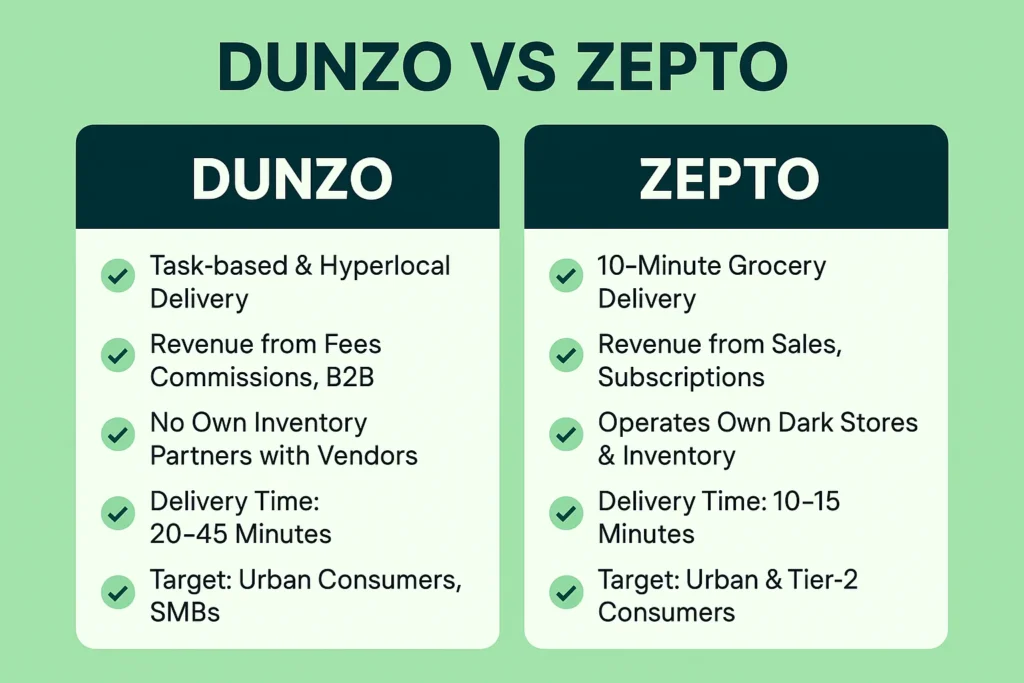In the fast-paced digital economy of 2025, the way urban Indians access groceries, essentials, and hyperlocal deliveries is transforming dramatically. Two standout players — Dunzo and Zepto — are leading this charge, each with unique business models that have evolved to meet changing consumer expectations and technological advancements.
Whether you’re a startup founder planning to build a hyperlocal delivery app or an app entrepreneur evaluating viable models for quick commerce (Q-commerce), understanding how Dunzo vs Zepto business models stack up is not just insightful—it’s essential. The models of these two giants offer powerful lessons in scaling logistics, optimizing last-mile delivery, and monetizing convenience.
This in-depth blog breaks down the revenue models, cost structures, key partnerships, and growth strategies of both platforms, helping you decide which model aligns with your business vision in 2025.
Let’s dive in.

What is Dunzo?
Dunzo is a hyperlocal delivery and task management platform that began in Bengaluru in 2015. Originally offering delivery of everything—from groceries and medicines to forgotten chargers and lunch boxes—Dunzo carved a niche as the “go-to errand partner” for urban millennials.
Key Offerings:
- Pickup & drop services (documents, items)
- Grocery and essentials delivery
- Restaurant food delivery (earlier integrated with third-party aggregators)
- Medicines and pet supplies
- Business logistics (Dunzo for Business)
As of 2025, Dunzo has strategically shifted focus toward enterprise logistics partnerships and B2B deliveries, while continuing to serve consumers through its app in select cities.
What is Zepto?
Zepto, launched in 2021 by two Stanford dropouts, redefined India’s grocery delivery market with its 10-minute delivery promise. Operating primarily through a dark store model, Zepto builds small, tech-enabled warehouses in high-density neighborhoods, enabling it to fulfill orders in record time.
Key Offerings:
- Instant grocery and essentials delivery
- Fresh fruits, vegetables, and dairy
- Proprietary brands and private labels
- Integrated payment and subscription systems
As of 2025, Zepto has expanded to Tier-1 and Tier-2 cities with a razor-sharp focus on efficiency, inventory control, and Q-commerce dominance.
Business Model of Dunzo
1. Revenue Streams
- Delivery Charges: From consumers based on distance and urgency.
- B2B Logistics: Enterprise clients pay for last-mile logistics via “Dunzo for Business”.
- Commission: From merchants, including grocery stores, restaurants, and pharmacies.
- Surge Pricing: Dynamic charges during peak hours or traffic bottlenecks.
- Subscription Plans: Dunzo Cash and Membership (free delivery, exclusive offers).
2. Cost Structure
- Rider salaries or commissions
- App development & tech stack
- Customer support and operations
- Marketing and discounts
- Partner payouts (restaurants, merchants)
3. Key Partners
- Local vendors (grocery, pharma, pet supplies)
- Logistics riders (individuals or fleet)
- Businesses (B2B deliveries for e-commerce, D2C brands)
- Payment gateways and fintech partners
4. Growth Strategy
- Focus on enterprise logistics (Dunzo for Business)
- Consolidation in fewer but profitable cities
- Strategic investment from Reliance Retail (Dunzo Direct)
- Automating and optimizing delivery routing
Learn More: Business Model of Dunzo : Revenue, Strategy & Insights
Business Model of Zepto
1. Revenue Streams
- Product Sales: Zepto earns margins by selling groceries directly from its dark stores.
- Delivery Fees: Nominal charges from customers per order.
- Private Labels: Higher margins through in-house product lines (e.g., Zepto Essentials).
- Subscription Model: Zepto Pass offering free deliveries and deals.
- Brand Partnerships: Sponsored listings and in-app promotions.
2. Cost Structure
- Dark store setup and maintenance
- Inventory procurement and warehousing
- Rider fleet and delivery operations
- Technology development (AI-powered routing, warehouse automation)
- Marketing and customer acquisition
3. Key Partners
- FMCG and grocery suppliers
- Local farmers and producers
- Logistics riders (fleet)
- Fintech and payment integrators
4. Growth Strategy
- Rapid city-wise expansion
- Efficient dark store operations using AI/ML
- Strengthening private label SKUs
- Focus on unit economics and low delivery times
Learn More: Business Model of Zepto : How Zepto Makes Money in 2025
Dunzo vs Zepto: Quick Comparison Table
| Feature | Dunzo | Zepto |
|---|---|---|
| Core Focus | Task-based + Hyperlocal Delivery | 10-minute Grocery & Essentials Delivery |
| Revenue Model | Delivery fees + Merchant commission + B2B | Direct sales + Subscription + Private label |
| Inventory Model | No inventory, works with partners | Operates its own dark stores |
| Delivery Time | 20–45 mins (on average) | 10–15 mins |
| Target Market | B2C + B2B (Urban India) | Urban & Tier-2 city consumers |
| Key Tech | Rider tracking, vendor tie-ups | Warehouse automation, AI-based routing |
| Monetization Opportunities | D2C logistics, Task-as-a-Service | In-app brand ads, exclusive product lines |
| Funding Backing | Reliance Retail | YC, Nexus, Glade Brook, StepStone |
Pros & Cons of Dunzo’s Business Model
Pros:
- Asset-light model (no warehousing costs)
- Flexible use cases (tasks, pick/drop, logistics)
- Corporate and SMB demand via Dunzo for Business
- Strong partner network (Reliance)
Cons:
- Heavily dependent on third-party vendors
- High operational costs per transaction
- Difficult to scale consistently across cities
- Unit economics under pressure due to discounts
Pros & Cons of Zepto’s Business Model
Pros:
- Full control over inventory and supply chain
- Higher margins via private labels
- Exceptional customer retention due to speed
- Scalable warehouse-first approach
Cons:
- Capital-intensive (dark store setup)
- Inventory risk and wastage
- High entry barrier for new startups
- Limited product catalog compared to open platforms
Market Data: Growth, Revenue, and Funding (as of 2025)
| Metric | Dunzo | Zepto |
|---|---|---|
| Est. Annual Revenue | ~$45M USD | ~$120M USD |
| Active Cities | 8+ (reduced focus) | 25+ |
| Total Funding | ~$140M (Reliance-led) | ~$400M+ |
| Monthly Active Users (MAU) | ~3 million | ~10 million |
| Valuation | ~$300M USD | ~$1.4B USD |
Which Model Is Better for Startups in 2025?
If you’re bootstrapped or looking to start small, Dunzo’s model offers flexibility and lower capital expenditure. However, if you aim to dominate the quick commerce market and have strong investor backing, Zepto’s model offers more long-term scalability, better customer retention, and higher margins through vertical integration.
The choice depends on:
- Capital availability
- Speed of scalability
- Target city demographics
- Risk tolerance for inventory
Choose Dunzo-Style Model If…
- You want a low-inventory, partner-driven model.
- You plan to offer diverse deliveries (not just groceries).
- You’re targeting urban professionals and SMBs.
- You want to scale logistics services without heavy CapEx.
Launch our Dunzo Clone App Solution to build a similar hyperlocal task delivery platform.
Choose Zepto-Style Model If…
- You want a controlled, fast grocery delivery experience.
- You’re ready to invest in dark stores and inventory.
- You aim to build a strong private-label grocery brand.
- You have the capital and team to manage logistics and warehousing.
Launch our Zepto Clone App Solution for building a Q-commerce business with 10-minute delivery capabilities.
Conclusion
Both Dunzo and Zepto have changed the way Indians shop and receive products at their doorsteps. For startup founders, the decision to adopt one model over the other depends on your business goals, budget, and operational capabilities.
At Miracuves, we help entrepreneurs like you develop tailored Dunzo and Zepto clone apps using best-in-class tech stacks and proven growth frameworks. Whether you prefer a task-driven or a dark-store model, our team can help you go to market faster.
Get in touch to start building your next-generation delivery app today!
FAQs
1. What is the main difference between Dunzo and Zepto business models?
Dunzo relies on partner integrations and an asset-light model, while Zepto operates its own inventory via dark stores for rapid grocery delivery.
2. Which business model requires more investment?
Zepto’s model requires higher upfront investment due to warehouse setup, inventory management, and logistics.
3. Can I launch a Dunzo-style app in Tier-2 cities?
Yes, Dunzo’s model works well in densely populated Tier-2 cities with diverse delivery needs.
4. Is 10-minute delivery really sustainable?
While it attracts users, the sustainability depends on strong logistics, demand forecasting, and cost optimization—Zepto is working toward this.
5. Does Miracuves offer white-label solutions for both models?
Yes, Miracuves provides fully customizable Dunzo and Zepto clone apps tailored to your startup’s needs — all starting at just $2899.








